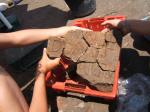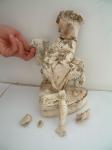Summary (English)
From April to August 2005, rescue archeological excavations continued at the location of the Barracks – Faculty of Agriculture, in P. Svačića Street in Osijek. The total excavated area is approximately 6500 m2. During those excavations in what used to be the western part of ancient Mursa, remains of an urban structure composed of six buildings with accompanying communal and road infrastructure, as well as numerous artefacts were found and studied. The investigated features are different from each other in terms of structure, architectural and structural elements, spatial organisation, size and function. On the basis of the architectural relations, the multi-layer stratigraphy and the temporal diversity of the material found, it is clear that during the course of time the form and purpose of the area and its features had been changing. The numerous artefacts discovered there, form now almost one third of the holdings of the Museum of Slavonia in Osijek accumulated to date, and a preliminary analysis has revealed that most of them can be dated to the 2nd and 3rd centuries AD. The material from Late Antiquity was preserved in closed units such as graves and wells. Archaeological excavations in 2005 investigated also 40 m of the Roman road (the total excavated length of the road is now approximately 100 m). The road stretches in the east-west direction and its width is 8.40 m. The road was built over two drainage channels 2.40 m wide, up to 4 m apart, up to 1.30 m deep. Drainage canals are filled with various building materials: bricks, imbrices, tegulae, plaster, but also architectural elements such as stone bases of pillars, pedestals and numerous ceramic, glass and metal finds, as well as grindstones. A fragmentary altar dedicated to the god Silvanus is a particularly interesting find. Above the fillings of the drainage canals, the pedimentum of the road has been preserved. The pedimentum is built of finely crushed brick bound with lime mortar, and the surface is roughly polished. Several phases of road reconstruction were identified. Some of the architectural remains will be presented in situ within the future Agriculture Faculty (S. Filipović, V. Katavić 2006, Hrvatski arheološki godišnjak 2/2005, 11–14).
- Slavica Filipović
- Vedran Katavić
Director
- Slavica Filipović
Team
- Vedran Katavić
Research Body
- Muzej Slavonije
Funding Body
- Sveučilište Josipa Jurja Strossmayera u Osijeku






![Download [PDF]](/excavation/skins/fasti/images/results/download_sml.png)

